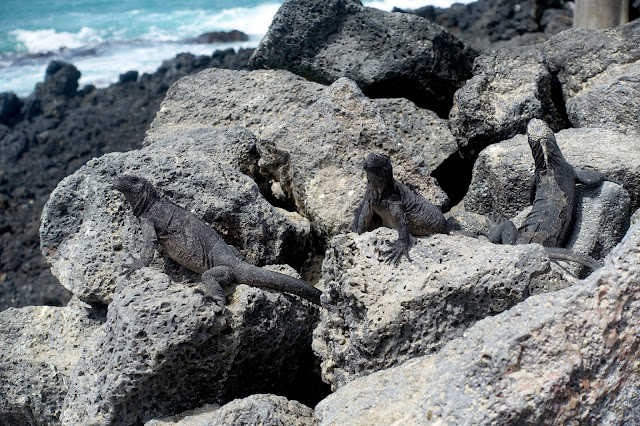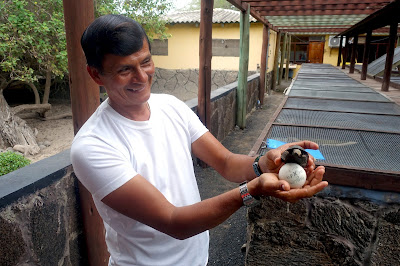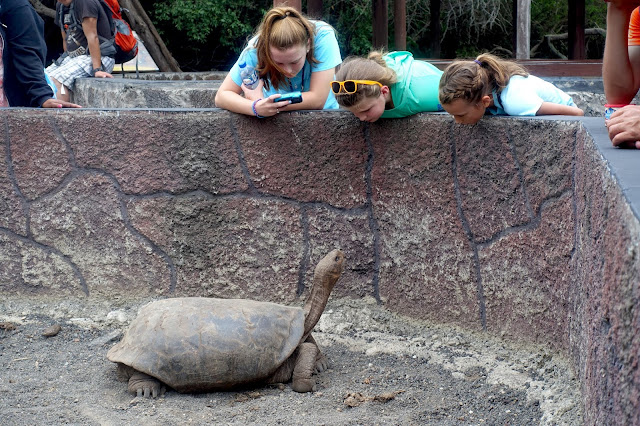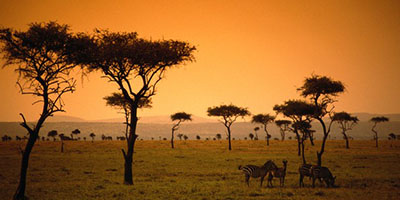Day 4: Santa Cruz to Isabela, Galapagos Islands
 |
| Porta Ayora, Santa Cruz |
This has been the absolute best day ever! We took a boat from Santa Cruz to Isabela Island, the home of 4 massive volcanoes. The landscape is vastly different with black volcanic rock visible everywhere. Along the way I even saw the backside of the crescent shaped island, Tortuga.
 |
| Tortuga Island |
The first thing I saw as soon as we reached Puerto Villamil was the bright red Sally Lightfoot crabs. They are everywhere! The adults are a bright red and orange color and the juveniles are black. This adaptation allows for the smaller and younger crabs to blend in with the volcanic rock to hide from predators. The bright red color on the adults acts as a warning to predators not to touch.
 |
| Sunbathing sea lions and a Sally Lightfoot crab. |
 |
| Marine iguanas sunbathing. |
The Galápagos Islands are all about being eco-friendly and recycling, so many of the vehicles and buildings on the islands are older and made of recycled materials. The climate on the islands stays pretty constant as well, so our bus had no need for air conditioning or heat. There were no windows (or doors for that matter) so we really got to enjoy the fresh air.
 |
| On the bus to head to the hotel. |
 |
| Hotel Cally |
 |
| Inside our room facing the front balcony. |
 |
| Relaxing on the roof. |
 |
| The view from the top of Hotel Cally! |
There were marine iguanas everywhere on the rocks. They blended in so well even I had a hard time spotting them. The formations of some of the volcanic rock was beautiful where you could see where it was flowing when it cooled. As the ocean waves crash into it, channels and openings are carved out and some of the detail is smoothed away.
 |
| Very young marine iguanas sunbathing on the rocks. |
 |
| The tide washing up over volcanic rock. |
Playa del Amor
 |
| The trail to Playa del Amor. |
 |
| The beach and some mangroves at Playa del Amor. |
 |
| A marine iguana posing majestically for me. |
There was one huge marine iguana on the back side of the beach. They are a whole lot easier to photograph than those birds!
 |
| Blue-footed boobies. |
 |
| Sally Lightfoot crabs. |
 |
| Into the mouth of the tunnel we all go. |
 |
| Inside the lava tunnel. |
 |
| The roof of the lava tunnel. |
Finishing off the trail was the wetlands where there was a nice lookout area to observe the flora and fauna. One unique species covering the area was the candelabra cactus. This cactus is drought resistant and can go long periods of time without any water. They grow very slow, only a few millimeters a year, and take centuries before they reach a large size. Some of the ones we saw were massive, so I can't even imagine how old they must be!
 |
| One of the inner wetland areas. |
We stopped at one more wetland estuary on our way to the next destination and saw some gorgeous flamingos. Flamingos mate for life, so where you find one, the other is sure to be close-by. This lake had 4 hanging out - 3 in one area and 1 not far off.
 |
| Flamingo Lake |
Galápagos Tortoise Breeding Center
 |
| Baby tortoises are so tiny! |
The younger tortoises are separated by age groups inside protected areas. Screens cover each area to prevent birds and other predators from harming them. Their shells are hard enough by 6 years old to be placed in an outside environment with more space. It takes around 50 to 60 years before the reach full size.
 |
| Protected areas for young tortoises. |
 |
| Tortoises in their encampments that mimic their natural environments. |
All around the breeding center were massive trees with fruit that looked like small apples. But beware, don't eat the apples! These trees are manchineel trees which are native to Galapagos. Only giant tortoises can digest the tiny apples that grow on them since they are poisonous to humans.
 |
| Manchineel trees. |
 |
| Scarlett and Shelly. |
Scarlett was pretty devastated when it was time to say good-bye.
 |
| The moment the first met, love at first sight! |
 |
| Shelly the tortoise. |
At the end of the day we had a chance to swing back by the beach, and I am so glad I did! The tide was out and the rock formations had created a pool-like area. Waves would roll in and poor water (along with fish) into the pocket. A very clever sea lion was taking advantage of the trapped fish and was swimming around having a feast! After its little belly was full, it hopped up on top of the rocks to groom and take a nap. It was such an awesome thing to witness!
 |
| Swimming around catching small fish. |
 |
| Getting ready for a nap. |
Tomorrow will be a full day here on Isabela Island!



Comments
Post a Comment